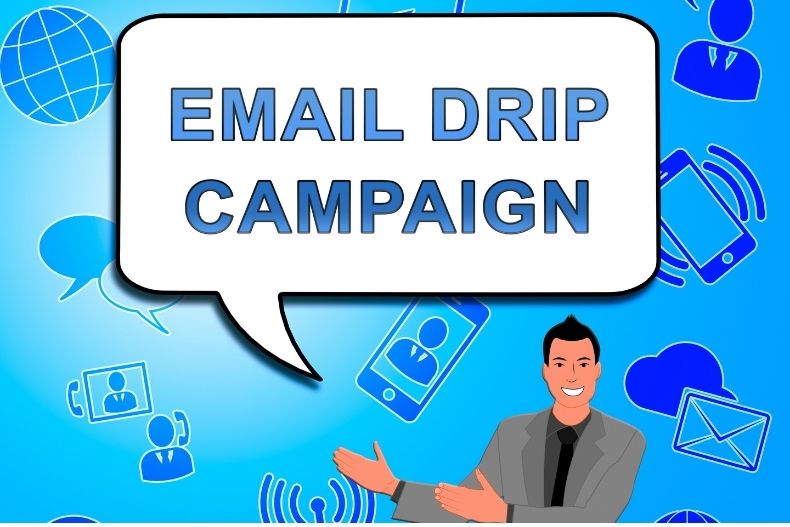Email marketing is important for building relationships with potential, current and even former customers as it gives you the opportunity to speak to them directly, in their inbox, at a time that suits them.
Drip email campaigns allow you to better and more effectively attract leads and customers. Emails sent based on user activity are more likely to receive a response because they are likely to be more relevant.
Drip campaigns can attract 50% more sales-ready leads through consistent customer communication. Companies that excel at drip campaigns generate 80% more sales for a 33% cost reduction. Company sales grew 20% after using drip campaigns to generate leads.

What is an email drip campaign?
Drip marketing is a type of communication strategy in which written or other types of messages are sent to the client with a certain regularity. Drip email marketing is the easiest to implement and most effective. The term originated from an analogy with the agricultural method of irrigation.
Often called drip campaigns but known by many other names — drip marketing, automated email campaigns, lifecycle emails, autoresponders and marketing automation — the concept is the same: they’re a set of marketing emails that will be sent out automatically on a schedule. Perhaps one email will go out as soon as someone signs up, another will go out 3 days later, with one more going out the next weekend.
Drip marketing is all about giving people the right information at the right time. If someone just subscribed to your blog newsletter, for example, a drip campaign could send a welcome email right away, and two days later, an email that shows off some of your most-read content.
Benefits of email drip campaign
- Boost engagement & loyalty – Emails initiated based on user actions are more likely to receive a response than standard email campaigns. Droplet email marketing allows you to reach leads better and more efficiently. Whether your user is renewing a subscription or buying a new product, you can use drip campaigns to engage customers in the renewal or new purchase process.
- Promote relevant content – When you know where your prospect is in your sales cycle, it’s very easy to send them content that matches their needs. The same happens when a new contact registers through the sign-up form on your site. With a proper email drip campaign in place, your emails already contain information that will go a long way to your recipients.
- Create a lead nurturing marketing funnel – When creating emails, remember where that person is in the sales funnel. If they just filled out a form and don’t know much about your brand, you are not going to send long-form emails. This leadership needs to be developed primarily by providing value-added content so that he or she can learn more about your brand.
- Help in increasing brand awareness – Drip campaigns help keep your business to focus on your customers. Fast recognition and recall will ensure that your business stays relevant, and drip marketing provides these “reminders” to customers.
- Re-engage – Retain the leads that aren’t closing in the segment and run an attention-grabbing campaign to warm them up. When they are finally ready to buy, you will still be in their field of vision. And reach out to current clients who haven’t been in touch recently. Try using drip email marketing to offer them larger and better products, cross-sell related products and services, or ask them to recommend your business to friends and colleagues. Be sure to give them an incentive to interact again.
When you’re creating a drip campaign for users who have abandoned their carts, be sure to make sure your email resonates with your brand, grabs readers’ attention, and generates enough curiosity for them to return to your site.
How to make your email drip campaign more effective
Drip campaigns are critical to educating, nurturing, and converting your leads. They play an important role in your overall marketing and sales game, so they must be assembled with great care, attention and strategy. You also need to have a solid understanding of what drives your prospects so that you can fill your campaigns with targeted content and the right message by checking an email address that will help them move more smoothly through the funnel.
Here are the main 6 steps to an effective email drip campaign:
-
- Figure out your goal.
- What’s in the emails matters most.
- Deliver the information that leads need to make a decision.
- Set the timing and frequency.
- Segment your campaigns.
- Measure stuff.
Putting together a drip campaign is a lot easier than you might think, once you have the right email validation tools. Create strong content. Focus on creating and sending high-quality (personalized) emails versus many general emails that don’t provide value. Determine which emails are most important and suppress less important ones. It is a matrix solution based on the purchase cycle, the focus of the emails, and the business unit that owns the email.
Analyze lead scores for campaigns and specific segments to understand how effective your marketing efforts are. Low overall engagement scores indicate a problem, while high or average scores indicate a marketing organization is performing well.
Conclusion
Drip campaigns are ongoing strategies. Tweak your practices and your content as needed, and always use any associated data to help evolve your campaigns. Soon, you’ll have a drip campaign that operates and excels.
Let drip campaigns run for a few months and then test how effective they are. Focus on how well they can drive leads down the funnel, and see if your sales team gets any feedback on the improvements. Also look at your click-through rate, open rate, and conversion rate to determine your overall success. Sometimes, something simple is enough to overcome obstacles, such as replacing updated and/or improved content.










